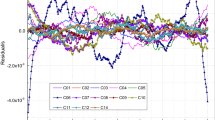Abstract
The satellite clocks of the BeiDou Navigation Satellite System (BDS) have characteristic differences compared to those of the global positioning system and Galileo. Therefore, the satellite clock offsets prediction method of BDS is different from those of these two systems. The basis for establishing a more appropriate prediction model is to clarify the statistical characteristics of the BDS satellite clock offsets, which can be reflected by fitting residuals of precise clock errors. Fractal behavior is generally not considered in existing studies. In this study, the rescaled range analysis method is improved by using the moving-average method in order to verify the fractal behavior of the BDS clock offsets. The computation results of the Hurst exponent show that the BDS clock offsets are fractal series with long-term memory, and the memory spans are obtained by V-statistic calculation. The quadratic polynomial fitting residuals of BDS clock offsets are fitted by using the periodic model and fractal interpolation model, where the latter approach has a higher accuracy. In the predictive modeling process, the quadratic polynomial forecasting model is improved by using the memory span, so that the forecasting model not only inherits the overall clock offsets trend but also considers the local memory trend. The fractal interpolation prediction model of the clock offsets is established by using the extension method of the affine iteration function system. The experimental results show that the average prediction accuracy of the fractal model in 3, 6, 12, and 24 h can reach 1.4890, 2.0222, 3.1609, and 4.9278 ns, which is 57.74%, 50.20%, 52.66%, and 49.42% higher than the products from the China iGMAS ultra-rapid prediction, respectively.
















Similar content being viewed by others
References
Ahmed E, Manoj D, Nobuaki K (2017) Maintaining real-time precise point positioning during outages of orbit and clock corrections. GPS Solut 21(3):937–947. https://doi.org/10.1007/s10291-016-0583-4
Defraigne P, Bruyninx C (2007) On the link between GPS pseudorange noise and day-boundary discontinuities in geodetic time transfer solutions. GPS Solut 11(4):239–249. https://doi.org/10.1007/s10291-007-0054-z
Greengard L, Lee J (2004) Accelerating the Non-uniform Fast Fourier Transform. SIAM Rev. 46(3):443–454. https://doi.org/10.1137/S003614450343200X
Han T (2016) Research on interoperability algorithm of global navigation satellite system. Dissertation, University of Chinese Academy of Sciences, Beijing, China
Han T, Yang YX, Huang GW, Jing W (2018) Fractal behavior of GNSS time offsets and fractal interpolation forecasting method for multi-GNSS time synchronization. GPS Solut 22(4):97. https://doi.org/10.1007/s10291-018-0762-6
Heo YJ, Cho J, Heo MB (2010) Improving prediction accuracy of GPS satellite clocks with periodic variation behavior. Meas Sci Technol 21(7):073001. https://doi.org/10.1088/0957-0233/21/7/073001
Huang GW, Cui BB, Zhang Q, Fu WJ, Li PL (2018) An improved predicted model for BDS ultra-rapid satellite clock offsets. Remote Sens 10(2):60. https://doi.org/10.3390/rs10010060
Hurst HE (1951) Long term storage capacities of reservoirs. Trans Am Soc Civ Eng 116(12):770–799. https://doi.org/10.1234/12345678
iGMAS (2018) International GNSS monitoring & assessment system. http://www.igmas.org/
Kaplan ED, Hegarty C (1996) Understanding GPS: principles and applications, 1st edn. House Publishers, Boston. ISBN 0-89006-793-7
Kouba J, Heroux P (2001) Precise point positioning using IGS orbit and clock products. GPS Solut 5(2):12–28. https://doi.org/10.1007/PL00012883
Liu ZP, Guo GL (2012) Fractal interpolation method for GPS precise satellite clock bias. J Astronaut 33(11):1623–1629. https://doi.org/10.3873/j.issn.1000-1328.2012.11.010
Ma JQ (2018) Update on the BeiDou satellite navigation system. In: The thirteenth meeting of the international committee on global navigation satellite systems (ICG), Xi’an, China, 5–9 November 2018. http://www.unoosa.org/documents/pdf/icg/2018/icg13/01.pdf
Mandelbrot BB, Wallis JR (1968) Noah, Joseph, and operational hydrology. Water Resour Res 4(5):909–918. https://doi.org/10.1029/WR004i005p00909
Mazel DS, Hayes MH (1992) Using iterated function systems to model discrete sequences. IEEE Trans Signal Process 40(7):1724–1734. https://doi.org/10.1109/78.143444
Montenbruck O, Hauschild A, Steigenberger P, Hugentobler U, Teunissen P, Nakamura S (2012) Initial assessment of the COMPASS/BeiDou-2 regional navigation satellite system. GPS Solut 17(2):211–222. https://doi.org/10.1007/s10291-012-0272-x
Peters EE (1994) Fractal market analysis: applying chaos theory to investment and economics. Chaos Theory. Wiley, New York
Qian B, Rasheed K (2004) Hurst exponent and financial market predictability. In: Proceedings of the 2nd IASTED international conference on financial engineering and applications, Nov 8–11, Massachusetts, USA
Vernotte F, Delporte J, Brunet M, Tournier T (2001) Uncertainties of drift coefficients and extrapolation errors: application to clock error prediction. Metrologia 38(4):325–342. https://doi.org/10.1088/0026-1394/38/4/6
Wang B, Lou YD, Liu J, Zhao Q, Su X (2016) Analysis of BDS satellite clocks in orbit. GPS Solut 20(4):783–794. https://doi.org/10.1007/s10291-015-0488-7
Yang YX, Cui XQ (2008) Adaptively robust filter with multi adaptive factors. Surv Rev 40(309):260–270. https://doi.org/10.1179/003962608X325330
Yang YX, Song LJ, Xu TH (2002) Robust estimator for correlated observations based on bifactor equivalent weights. J Geod 76(6–7):353–358. https://doi.org/10.1007/s00190-002-0256-7
Zhao QL, Guo J, Li M, Qu L, Hu Z, Shi C, Liu J (2013) Initial results of precise orbit and clock determination for COMPASS navigation satellite system. J Geod 87(5):475–486. https://doi.org/10.1007/s00190-013-0622-7
Acknowledgment
This study was supported by Shaanxi Postdoctoral Research Fund (No. 2017BSHEDZZ22), Natural Science and Technology Fund of the Shaanxi Provincial Education Department (No. 17JK1077), National Natural Science Fund of China (Nos. 41774025, 61976176).
Author information
Authors and Affiliations
Corresponding author
Additional information
Publisher's Note
Springer Nature remains neutral with regard to jurisdictional claims in published maps and institutional affiliations.
Rights and permissions
About this article
Cite this article
Han, T. Fractal behavior of BDS-2 satellite clock offsets and its application to real-time clock offsets prediction. GPS Solut 24, 35 (2020). https://doi.org/10.1007/s10291-019-0950-z
Received:
Accepted:
Published:
DOI: https://doi.org/10.1007/s10291-019-0950-z




